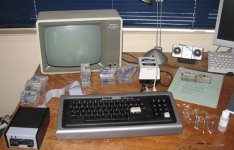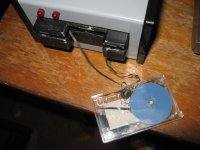tezza
Veteran Member
Hi,
Just thought ppl might like to hear about my stringy floppy adventure today.
The stringy floppy drive replaced the cassette player as storage media of choice on my TRS-80 clone for about a year until disk drives fell to within my reach (see http://www.webweavers.co.nz/system-80/hardware_accessories.htm#stringy) . When I fired up the machine last year after years of inactivity I found the belt had perished.
billdeg (of this forum) kindly sent me a new belt for my beltless stringy floppy drive (thanks Bill). It arrived yesterday. This afternoon with the new belt in place, I fired up the stringy floppy drive to see which of my many wafers could be read.
Holy gunk Batman! After every second wafer I needed to clean the head and spindle with Isopropyl alcohol, such was the build up of residue. I guess that could be expected considering these wafers hadn’t seen the inside of the drive for 25 years.
Anyway, after an afternoon and evening of testing the statistics are:
Wafers that snapped – 21
Wafers eaten by the drive – 2
Wafers where the tape jammed up inside the cartridge and would not spool – 31
Wafers that seemed ok but would not format (media damaged) – 7
Wafers that formatted. (so were ok) – 14
Better than I could have hoped probably considering thy spent 15 years in a roof cavity under iron where temperatures easily reached 65 deg Celsius or more in the summer. Of course I never considered vintage computing would ever be a hobby way back then.
Anyway, it’s cool to have a stringy floppy drive now hanging off my 16k TRS-80 Model 1 AND to have at least SOME wafers that are still ok.
I’ve uploaded some pics of today’s project.
Just thought ppl might like to hear about my stringy floppy adventure today.
The stringy floppy drive replaced the cassette player as storage media of choice on my TRS-80 clone for about a year until disk drives fell to within my reach (see http://www.webweavers.co.nz/system-80/hardware_accessories.htm#stringy) . When I fired up the machine last year after years of inactivity I found the belt had perished.
billdeg (of this forum) kindly sent me a new belt for my beltless stringy floppy drive (thanks Bill). It arrived yesterday. This afternoon with the new belt in place, I fired up the stringy floppy drive to see which of my many wafers could be read.
Holy gunk Batman! After every second wafer I needed to clean the head and spindle with Isopropyl alcohol, such was the build up of residue. I guess that could be expected considering these wafers hadn’t seen the inside of the drive for 25 years.
Anyway, after an afternoon and evening of testing the statistics are:
Wafers that snapped – 21
Wafers eaten by the drive – 2
Wafers where the tape jammed up inside the cartridge and would not spool – 31
Wafers that seemed ok but would not format (media damaged) – 7
Wafers that formatted. (so were ok) – 14
Better than I could have hoped probably considering thy spent 15 years in a roof cavity under iron where temperatures easily reached 65 deg Celsius or more in the summer. Of course I never considered vintage computing would ever be a hobby way back then.
Anyway, it’s cool to have a stringy floppy drive now hanging off my 16k TRS-80 Model 1 AND to have at least SOME wafers that are still ok.
I’ve uploaded some pics of today’s project.



